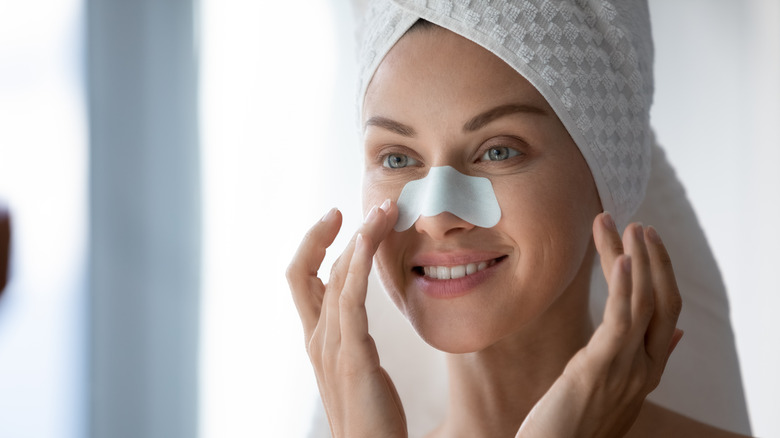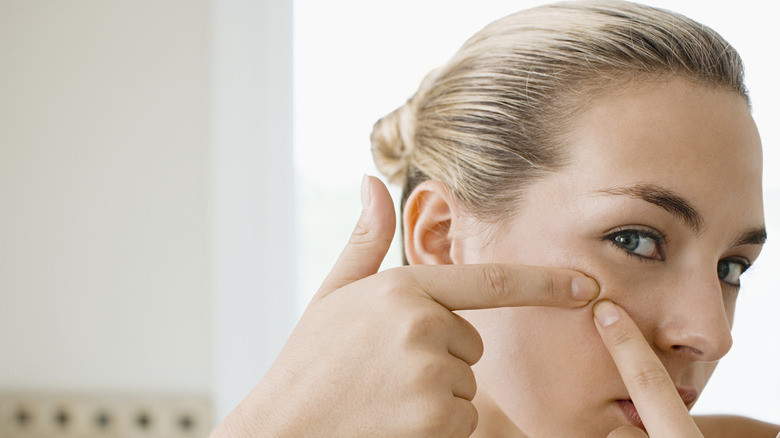Sebaceous Filaments Vs. Blackheads: What's The Real Difference?
Whiteheads, blackheads, acne, sebaceous filaments, the list of skin terms is endless. With so many ways to describe different skin issues, it's easy to get confused. For example, acne typically can get confused for a whitehead. Bioclarity defines whiteheads as clogged pores that are slightly covered by a thin skin. A whitehead would ultimately be caused and treated differently than other types of acne. Although many of these terms are very similar, their differences could mean treating them differently. While proper skin care will alleviate many skin issues, knowing exactly what you are suffering from will make treatment much simpler.
Two terms that also often get interchanged are sebaceous filaments and blackheads. While they may seem the same, these two are different skin issues you may have. Knowing their difference will help in prevention and treatment, saving you time and money. Even though all of these skin issues are ultimately connected, knowing what makes them different can get you closer to the glowy and clear skin you want.
What are sebacious filaments?
If you've ever seen your nose and immediately felt the need to grab a nose strip to remove all of the black dots, you've probably seen sebaceous filaments. Although they are commonly mistaken for blackheads, sebaceous filaments are much more common than people are aware of. Saya Skin describes sebaceous filaments as a natural part of your skin that is produced when oil surrounds a hair follicle. Not exactly a skin issue, sebaceous filaments help the oil filter naturally to your skin. These parts are helpful to the skin as they keep it moisturized, unlike blackheads.
Dr. Rachel Nazarian explains to Prevention that while sebaceous filaments may look full, they are not any sign of a skin issue. Although it is possible to get them cleaned out by a professional, this isn't recommended as they will continue to return, as they are a natural part of the skin. Dr. Nazarian explains that sebaceous filaments are a base for the formation of blackheads but do not pose any issue in themselves. Sebaceous filaments might seem more apparent if you have enlarged pores or oily skin, as surrounding dead skin cells and dirt will give them a more grey color. While you might be tempted to squeeze them, they will only continue to reappear, and squeezing the skin will likely only continue hurting your skin even more.
What is a blackhead?
Unlike sebaceous filaments, blackheads can be treated and prevented with a proper skincare routine. Adore Beauty explains blackheads as a pimple that begins forming within the pore. A blackhead is a pore clogged by excess oil, dead skin cells, and dirt. They get their black color from the fact that these clogged items get oxidized from being open to the air. Those with oily skin and large pores are also lucky to suffer from blackheads as well as more apparent sebaceous filaments. If you aren't sure whether it is a blackhead or not, simply run your figures over the dot. If it feels like it has texture or is raised, it is most likely a blackhead. Since blackheads fill in the pore and are raised, making them stick out even more.
According to Biore, blackheads are only temporary. With a simple mixture of ingredients, you can cleanse out the open pore and get rid of the trapped gunk inside of it. Ingredients like salicylic acid can help dissolve everything trapped inside the pore, getting it clean and empty once again. Consistently cleaning and toning your skin will help with oil balance and the pores from getting trapped by excess oil and dirt again. If you want to prevent blackheads, you want to ensure that you are keeping the face and body as clean as possible. Unlike sebaceous filaments, blackheads can occur on the face, arms, and back.


